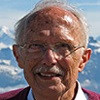7.4.6: National Science Foundation (NSF)
- Page ID
- 6293
Overview
The National Science Foundation (NSF) receives about 30 percent of NEHRP funding, divided into two areas, administered by two directorates within NSF. The largest amount goes to earthquake engineering, including direct grants to individual investigators. Part of the budget goes to three earthquake-engineering research centers in New York (established in 1986), Illinois, and California (both established in 1997). The Pacific Earthquake Engineering Research Center (PEER) in Richmond, California is operated by the University of California at Berkeley, one of the leading institutions in the world for earthquake engineering research.
The George E. Brown, Jr., Network for Earthquake Engineering Simulation (NEES), headquartered at Purdue University in West Lafayette, Indiana, is a new NSF program to test the response of buildings to earthquakes. Ideally one would subject a building to actual shaking, and commonly this is done by putting it on a foundation that shakes, but the building size is limited. NEES does it by computer simulation. More information is available at http://www.nees.org.
Part of the budget of the engineering research centers comes from NSF, but an equal amount is expected to come from other sources. The Buffalo (New York) Center has received money from the Federal Highway Administration for research into the seismic vulnerability of the national highway system. Other research includes geotechnical engineering studies of liquefaction, tsunamis, and soil response to earthquakes, and the response of structures to ground motion. The NEES center in the Pacific Northwest is located at Oregon State University and includes the O.H. Hinsdale Tsunami Wave Tank Laboratory, one of the largest tsunami wave tanks in the world, where experiments are conducted on the effects of tsunami waves on buildings. A category called earthquake systems integration includes research in the behavioral and social sciences and in planning, including code enforcement and how to decide whether to demolish or repair a building.
The directorate of NSF that includes the geosciences funds grants to individual scientists and to three university consortia—the Incorporated Research Institutions for Seismology (IRIS), the Southern California Earthquake Center (which also receives support from the USGS), and the University Navstar Consortium (UNAVCO), which provides technical assistance and equipment for geodetic studies of crustal deformation using GPS. IRIS is building a global network of state-of-the-art digital seismographs. IRIS provides NEHRP with assessments of the frequency of earthquakes worldwide and their expected ground motion. It is developing a program to deploy seismographs in the field immediately after a large earthquake or volcanic event. The Data Management Center of IRIS is housed in Seattle. IRIS also prepares summaries (teachable moments) of major earthquakes worldwide, using the seismograph at the University of Portland operated by Robert Butler and videos prepared by Jenda Johnson and Robert Butler.
Direct grants from NSF to individual investigators include research into the study of earthquake sources, of active faults and paleoseismology, and of shallow crustal seismicity. In FY 1990, instrument-based studies in seismology and geodesy received the bulk of the funding.
Although the Ocean Sciences Directorate in NSF has no focused program in earthquake studies, projects attached to oceanographic cruises with other primary objectives have made important discoveries, including a set of seafloor faults that cut across the Cascadia Subduction Zone, discovered in an NSF-sponsored cruise in preparation for a research drilling program off Cascadia in 1992. A set of seismic-reflection profiles, also preparatory to the drilling project, imaged the plate-boundary fault directly (cf. Figures 4-2, 4-4). Tube worm and clam communities in the vicinity of the Cascadia Subduction Zone were discovered on a cruise to work out the migration of fluids in subduction zones; those fluids were found to travel along active faults. The new Integrated Ocean Drilling Program includes major research on subduction zone earthquakes, including a project to acquire cores within the subduction zone fault itself. The Japanese coring vessel Chikyu has sampled the source fault of the March 2011 Tohoku-oki Earthquake


